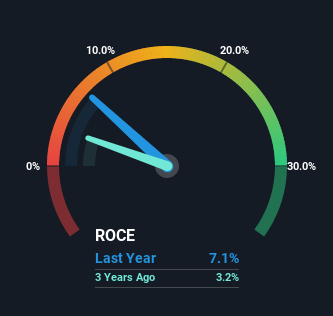- United States
- /
- Energy Services
- /
- NasdaqGS:BKR
Baker Hughes (NASDAQ:BKR) Is Doing The Right Things To Multiply Its Share Price
There are a few key trends to look for if we want to identify the next multi-bagger. Amongst other things, we'll want to see two things; firstly, a growing return on capital employed (ROCE) and secondly, an expansion in the company's amount of capital employed. Ultimately, this demonstrates that it's a business that is reinvesting profits at increasing rates of return. So when we looked at Baker Hughes (NASDAQ:BKR) and its trend of ROCE, we really liked what we saw.
What Is Return On Capital Employed (ROCE)?
If you haven't worked with ROCE before, it measures the 'return' (pre-tax profit) a company generates from capital employed in its business. To calculate this metric for Baker Hughes, this is the formula:
Return on Capital Employed = Earnings Before Interest and Tax (EBIT) ÷ (Total Assets - Current Liabilities)
0.071 = US$1.7b ÷ (US$34b - US$9.4b) (Based on the trailing twelve months to June 2022).
Therefore, Baker Hughes has an ROCE of 7.1%. On its own that's a low return, but compared to the average of 5.8% generated by the Energy Services industry, it's much better.
Check out our latest analysis for Baker Hughes

Above you can see how the current ROCE for Baker Hughes compares to its prior returns on capital, but there's only so much you can tell from the past. If you'd like to see what analysts are forecasting going forward, you should check out our free report for Baker Hughes.
What Can We Tell From Baker Hughes' ROCE Trend?
We're glad to see that ROCE is heading in the right direction, even if it is still low at the moment. Over the last five years, returns on capital employed have risen substantially to 7.1%. The company is effectively making more money per dollar of capital used, and it's worth noting that the amount of capital has increased too, by 29%. So we're very much inspired by what we're seeing at Baker Hughes thanks to its ability to profitably reinvest capital.
What We Can Learn From Baker Hughes' ROCE
To sum it up, Baker Hughes has proven it can reinvest in the business and generate higher returns on that capital employed, which is terrific. Since the total return from the stock has been almost flat over the last five years, there might be an opportunity here if the valuation looks good. With that in mind, we believe the promising trends warrant this stock for further investigation.
One more thing, we've spotted 1 warning sign facing Baker Hughes that you might find interesting.
While Baker Hughes may not currently earn the highest returns, we've compiled a list of companies that currently earn more than 25% return on equity. Check out this free list here.
Valuation is complex, but we're here to simplify it.
Discover if Baker Hughes might be undervalued or overvalued with our detailed analysis, featuring fair value estimates, potential risks, dividends, insider trades, and its financial condition.
Access Free AnalysisHave feedback on this article? Concerned about the content? Get in touch with us directly. Alternatively, email editorial-team (at) simplywallst.com.
This article by Simply Wall St is general in nature. We provide commentary based on historical data and analyst forecasts only using an unbiased methodology and our articles are not intended to be financial advice. It does not constitute a recommendation to buy or sell any stock, and does not take account of your objectives, or your financial situation. We aim to bring you long-term focused analysis driven by fundamental data. Note that our analysis may not factor in the latest price-sensitive company announcements or qualitative material. Simply Wall St has no position in any stocks mentioned.
About NasdaqGS:BKR
Baker Hughes
Provides a portfolio of technologies and services to energy and industrial value chain worldwide.
Flawless balance sheet with proven track record.
Similar Companies
Market Insights
Community Narratives



